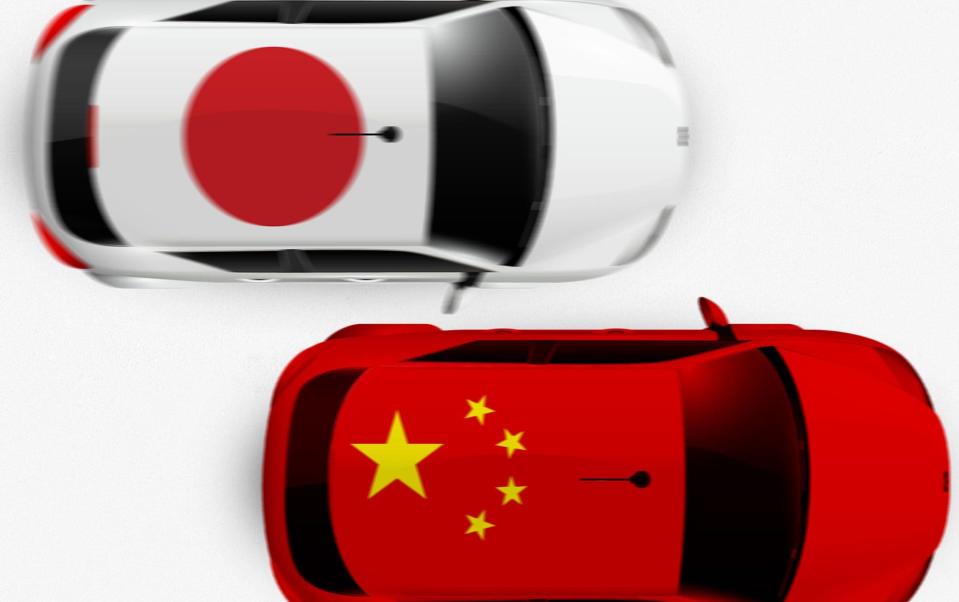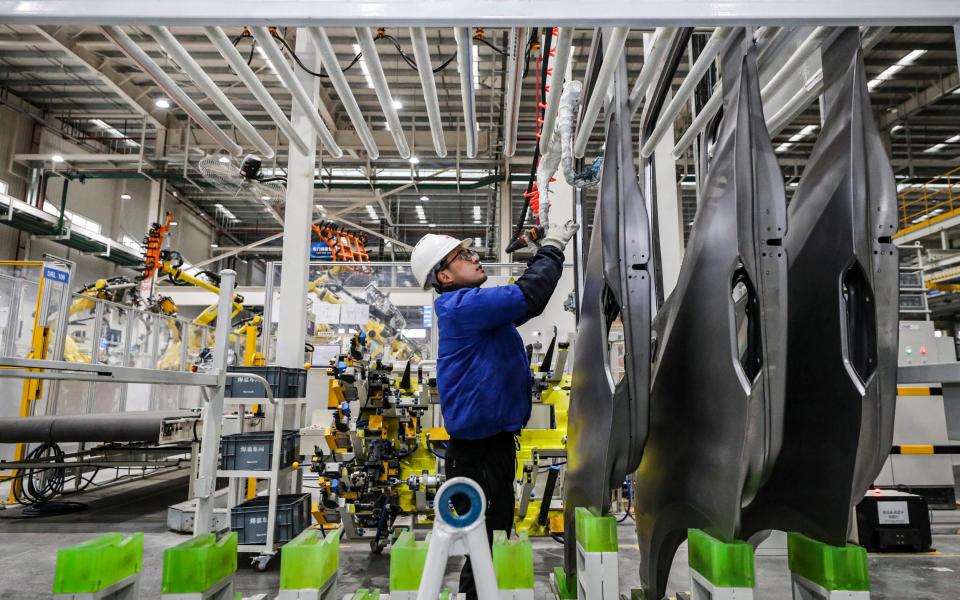How a Chinese car invasion forced Japan into an unthinkable alliance


Perched next to a motorway exit in a leafy Tokyo suburb, a grey-coloured BYD dealership might not look particularly special.
Yet from this street corner, China’s biggest electric vehicle (EV) company has launched an audacious bid to break into the notoriously closed Japanese market.
By the end of next year, 100 more dealerships like it are planned across the country.
In each one, BYD (which stands for “Build Your Dreams”) will push its new Dolphin hatchbacks that sell for as little as 3.6 million yen (about £18,900) each.
“Finally, we can offer new options in Japan’s automotive market,” said Atsuki Tofukuji, president of BYD Auto Japan, at the first dealership’s launch last year. “I’m so excited.”
Others, however, are decidedly less enthused about the coming Chinese invasion.
Japan’s biggest carmakers Toyota, Nissan and Honda – known as the “Big Three” at home – are seeing their market shares come under attack by China’s automotive champions. It is not just a problem in Japan – competition is ramping up around the world.
Now, a fightback has begun.
In a move that stunned the car industry last week, Nissan and Honda ended decades of bitter rivalry to announce they were teaming up to develop EVs together.
The previously unthinkable alliance will also cover software platforms and other related products, with bosses admitting they risk being “shaken out” unless they join forces.
“Japan has fallen very far behind in the EV model, whereas the Chinese have been very front-footed,” says Andy Palmer, a former Nissan executive known as the “Godfather of EVs”.
“I think what’s happened is a slow realisation among the Japanese that EVs are now inevitable – and therefore, you’ve got to get back in the game.”
While China has set out to become the undisputed leader in electric cars, supporting manufacturers with massive state subsidies, Japan has been more reluctant to embrace them.
In 2023, more than 8m new EVs or plug-in hybrids were sold in China, representing about 37pc of the market. Only 88,535 EVs were sold in Japan over the same period – just 2.2pc of the total.
At the same time, Chinese brands such as BYD, Geely, Chery and Nio have also spent years honing their battery technologies and driving down costs, while fighting cut-throat price wars against one another.
That has given them a formidable head start, particularly on prices.
At home, BYD sells its Dolphin model for just 99,800 yuan (£11,000), while the even cheaper Seagull starts at just 69,800 yuan (£7,700). Prices are higher overseas but it suggests they still have room to cut if competition heats up.
By comparison, Japanese carmakers have largely eschewed the push into EVs so far, launching only a tiny handful of cars between them. Executives have also repeatedly questioned their appeal.
Instead, Toyota, Honda and Nissan have pushed hybrids, which they have pioneered since the late 1990s. These models, such as Toyota’s best-selling Prius, have proved popular with consumers because of their impressive fuel efficiency.
At the same time, Toyota and Honda have also invested heavily in developing hydrogen fuel cell cars. However, the technology has failed to take off, with hydrogen infrastructure almost non-existent outside Japan.
As more governments push consumers towards EVs in an effort to cut carbon emissions, Japan’s Big Three look increasingly vulnerable.
“Japan is lagging behind China, Europe and even the US and Korea when it comes to EVs,” says Felipe Munoz, an automotive analyst at JATO Dynamics.
“They have invested a lot in hybrid technology and that’s the way they wanted to continue.
“But the EV is becoming reality, and now the Japanese brands are losing ground in some markets due to the rise of Chinese products, even in places where they have traditionally been very strong.”
Japanese brands once did well in China itself but are now in retreat. Last year, Toyota, Nissan and Honda haemorrhaged sales there, with Nissan and Honda deciding to scale back production in the face of fierce competition from local brands.
In Thailand, Chinese brands also doubled their share of new car sales to 11pc in 2023 – while Japanese brands saw theirs slip from 86pc to 78pc. Not so long ago, Japan’s marques enjoyed a market share of more than 90pc.
Within the EV category, however, they are hardly even registering. Chinese companies accounted for 80pc of Thai EV sales, while their Japanese rivals managed less than 1pc.
In Indonesia, a similar story is emerging. While the Japanese still dominated more than 90pc of the total car market last year, China’s Wuling Motors took a 78pc share of EV sales followed by Korea’s Hyundai at 20pc. Toyota trailed behind with just 1.4pc.

Over in Latin America, including in Brazil and Mexico, BYD and other Chinese brands are also seeking to take on their Japanese rivals by building local factories.
“Southeast Asia is a key region for the Japanese, as well as the Middle East – especially for Toyota – and Latin America,” adds Munoz. “But in all three of these regions, their position is being threatened by China.”
In Toyota’s case, many analysts view the company as strong enough to turn things around, partly thanks to the huge profits it is still reaping from sales of hybrids.
Toyota claimed to have developed what many experts say would be a game-changer last summer: a solid-state EV battery with a potential range of 750 miles – and a charging time of just 10 minutes.
The company has claimed it will be ready to launch the technology in commercial vehicles in as little as two years’ time.
However, there still seems to be some institutional reluctance to fully embrace EVs. Akio Toyoda, the chairman, has predicted that EVs will only ever reach 30pc of global car sales, arguing instead for a “multi-pathway” approach that encompasses hybrids and hydrogen-powered cars as well.
Last year, Toyota shifted 104,000 EVs – less than 1pc of the company’s total sales.
For Nissan and Honda the situation is more difficult. Nissan previously developed the Leaf, one of the best-known electric cars on the roads, but arguably failed to capitalise on that success. It failed to create a common EV platform with Renault, its French alliance partner, says former executive Palmer. Establishing these common “rules of the road” around how EVs would be built would have helped it gain global efficiencies of scale.
Meanwhile, Honda has barely launched any EV models and does not expect to unveil any new electric cars until 2026.
While Nissan and Honda lack Toyota’s scale and the resources to catch up on their own, together they stand a better chance, says Andrew Bergbaum, partner and global co-leader for automotive at AlixPartners.
“I think [the Nissan-Honda collaboration] is a way of leveraging Japan Inc in highly complicated and highly technical areas, where even just having a shared language can be the difference between success and failure,” he says.
Palmer agrees: “Toyota will be fine. So in that context, it makes sense for the smaller players, Honda and Nissan, to come together.”
The question now is whether Japan’s Big Three can really turn the tables on the likes of BYD and fight a rearguard action against the Chinese upstarts.
On that point, most analysts can agree on one thing: it would be foolish to underestimate Japanese ingenuity.
“The Japanese carmakers are very strong,” says Munoz. “They have shown all over these years that they know the markets and they understand their customers around the world.
“I think they have the capabilities to catch up.”
